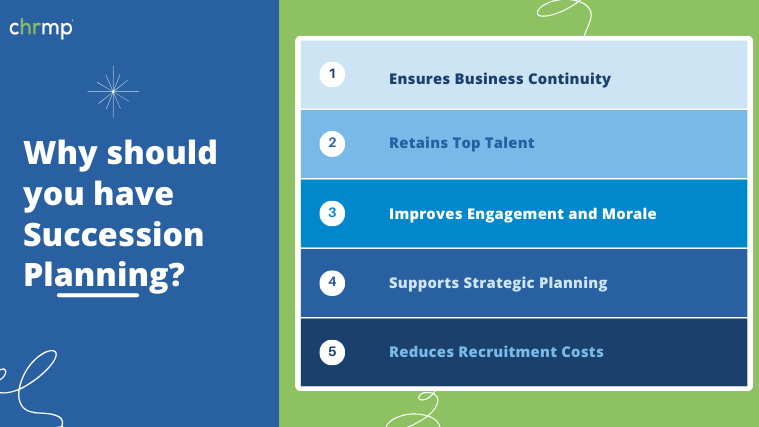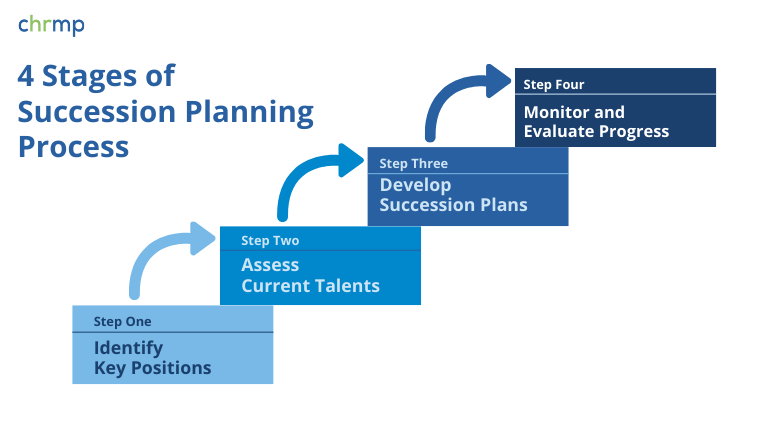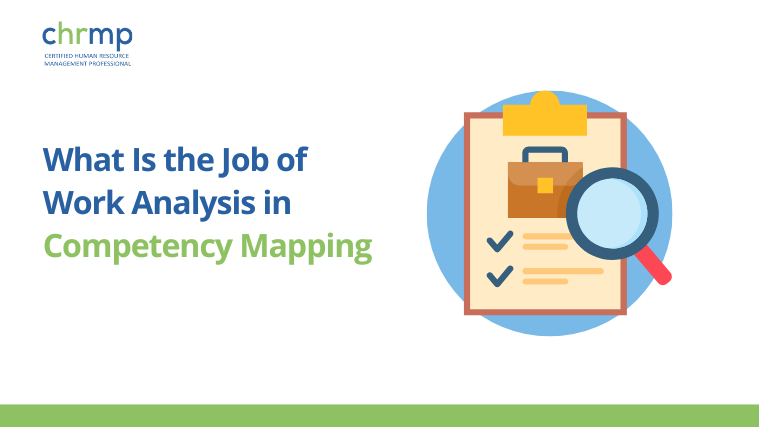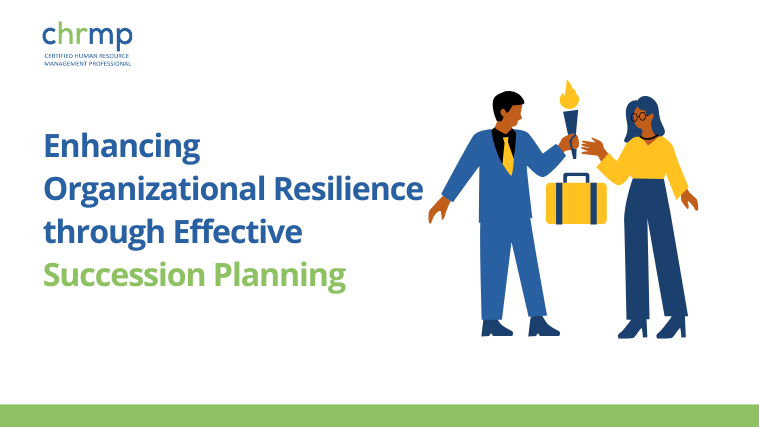Understanding Succession Planning:
Succession planning is a strategic imperative for any business, whether a burgeoning startup or an established multinational corporation. It systematically identifies and grooms potential leaders within the organization, ensuring they are ready to take the helm when current leaders depart due to retirement, resignation, or unexpected events.
This proactive approach not only prepares the organization for seamless transitions but also cultivates a robust leadership pipeline that supports long-term success and stability.
Succession planning is fundamentally about ensuring operational continuity and strategic foresight. Its objective is to preempt disruptions that could occur from sudden leadership gaps, thereby maintaining the momentum of the organization’s growth and the integrity of its operations.
Components of Succession Planning:
Key components of succession planning include:
- Talent Assessment: Rigorously evaluating the abilities, performance, and potential of current employees to pinpoint emerging leaders.
- Development Initiatives: Designing specific training and development programs to equip identified candidates with essential leadership skills and knowledge.
- Strategic Alignment: ensuring that the succession strategy aligns seamlessly with the organization’s long-term goals and objectives, adapting to future challenges and opportunities.
Importance of succession planning:
A well-crafted succession plan is critical for sustaining leadership continuity and can significantly enhance organizational resilience. The benefits of implementing such a strategy are manifold.
- Leadership Continuity: Provides a smooth transition in leadership, preventing disruptions in strategy implementation and day-to-day operations.
- Talent Retention and Attraction: By offering career progression opportunities, it helps in retaining high-potential employees and attracting new talent who see clear career paths within the organization.
- Risk Mitigation: This reduces the vulnerability associated with the unexpected loss of key leaders and ensures that the business remains resilient in the face of such challenges.
Building a Future-Ready Organization:
Implementing effective succession planning is more than just a risk management tactic; it is a growth strategy that prepares the organization to face future challenges head-on. By nurturing a culture that values continuous learning, leadership development, and strategic foresight, businesses can not only survive but thrive in the competitive landscapes of tomorrow.
This approach ensures that the organization is always ready to advance, with a team of capable leaders who can take the reins and drive success.
Maximizing Organizational Potential with Strategic Succession Planning:

Succession planning is more than just a safety net for your organization; it’s a strategic tool that ensures the stability and growth of your business in the face of leadership changes. Here are five compelling benefits of integrating succession planning into your HR framework:
- Ensures Business Continuity:
Succession planning secures your organization against the uncertainties of leadership transitions. By developing a robust pipeline of future leaders, you ensure that critical roles are never left vacant or filled hastily. This strategic foresight allows for the smooth continuation of business operations, minimizing disruptions and maintaining organizational momentum even during unexpected leadership changes.
- Retains top talent:
A clear succession plan signals to your employees that there are tangible growth opportunities within the organization. By mapping out potential career paths and investing in development programs, you not only enhance the skill set within your company but also significantly increase employee retention rates. Employees who see a future within the company are more likely to remain engaged and committed to your organizational goals.
- Improves Engagement and Morale:
Succession planning is a testament to an organization’s commitment to its employees’ growth and development. When team members recognize that they are valued and that there are opportunities for advancement, morale, and engagement levels surge. This boost in employee sentiment can lead to increased productivity and performance, directly impacting the bottom line positively.
- Supports Strategic Planning:
Effective succession planning aligns closely with your organization’s strategic objectives. By identifying key roles and the competencies needed for these positions, HR can tailor development programs that prepare employees not just for future roles but also to drive the company’s strategic goals.This alignment ensures that the organization is well-prepared to tackle future challenges and seize opportunities.
- Reduces recruitment costs:
By nurturing internal talent for critical roles, succession planning can significantly cut down on external recruitment costs. Internal candidates not only reduce hiring timelines but are also likely to adapt quicker and perform better, having been ingrained with the company’s culture and processes.This strategic internal talent development can lead to substantial cost savings and improved organizational synergy. Effective succession planning is indispensable for any forward-thinking organization. It not only ensures a seamless transition during periods of change but also fosters a culture of continuous improvement and employee loyalty.
By investing in a thoughtful succession strategy, organizations can protect themselves from potential disruptions, optimize employee potential, and align workforce capabilities with long-term business goals.

Succession planning is a structured approach that prepares organizations for inevitable leadership transitions, ensuring stability and continuity. Understanding and implementing a clear, step-by-step succession planning process is crucial for any business aiming to maintain a competitive edge and minimize disruptions during key personnel changes.
Step 1: Identification of Key Positions
The first step in effective succession planning is to pinpoint the key positions within the organization that are critical to its operational and strategic success. These roles often include executive leadership, department heads, and other pivotal positions essential for both day-to-day functions and long-term achievements.
Early identification of these roles allows organizations to strategically prepare for future transitions, ensuring that no critical function is left vulnerable due to unexpected vacancies.
Step 2: Assess Current Talent
After identifying key positions, the next step involves a thorough assessment of the current workforce to determine who could potentially fill these roles. This assessment is typically conducted through a combination of performance reviews, employee interviews, and other talent evaluation tools.
The goal is to identify employees who not only have the necessary skills and experiences but also the ambition and readiness to assume higher responsibilities. This stage is crucial for pinpointing potential leaders and planning their development trajectory within the company.
Step 3: Develop Succession Plans
With potential successors identified, individualized succession plans should be crafted for each candidate. These plans may include specialized training, mentorship opportunities, and rotational assignments across different organizational functions to provide a well-rounded experience.
Each plan should be tailored to fit the unique needs and career aspirations of the successor, ensuring they are both challenged and supported in their developmental journey. This personalized approach helps maintain engagement and commitment to the organization.
Step 4: Monitoring and Evaluation of Progress
The final step in the succession planning process involves ongoing monitoring and evaluation of the identified successors. This includes regular performance evaluations, feedback sessions, and adjustments to their development plans based on evolving organizational needs and personal growth.
Regular check-ins and updates are vital to ensure that potential leaders are on track to meet their career objectives and that the succession plans remain aligned with the organization’s goals. Flexibility in adjusting these plans is essential to accommodate both organizational shifts and individual development needs.
By following these four steps, organizations can cultivate a robust pipeline of capable leaders ready to step into critical roles as needed.
This proactive approach not only ensures business continuity but also contributes to a dynamic, adaptable, and forward-thinking organizational culture.
Succession planning is not a one-time event but a continuous cycle that supports strategic business growth and leadership development.
Essential Succession Planning Metrics for HR Professionals
For HR professionals, monitoring specific metrics can significantly enhance the effectiveness of succession planning strategies. These metrics provide essential insights into the readiness of the organization to handle leadership transitions smoothly.
Here are the top five succession planning metrics that every HR professional must know and track:
- Replacement Planning Rate:
This metric refers to the percentage of key organizational positions for which potential successors have been identified. A high replacement planning rate suggests that an organization has a proactive and robust succession planning strategy in place, ready to manage leadership transitions effectively.
Replacement Planning Rate = (Number of key positions with identified successors/Total number of key positions)×100
This formula calculates the percentage of key roles in an organization that has at least one identified potential successor, indicating preparedness for leadership transitions
HR professionals should monitor this rate closely to ensure comprehensive coverage of all critical roles. However, balancing talent retention with a high replacement rate is crucial, as it can sometimes lead to tensions within the talent management strategy.
- Succession Pipeline Depth:
The succession pipeline depth measures the number of potential successors lined up for each key position. A deep pipeline indicates a strong bench strength, ensuring that multiple candidates are ready to step into leadership roles as required.
Succession Pipeline Depth=Total number of identified successors/Total number of key positionsThis metric assesses the robustness of your succession pipeline by averaging the number of potential successors per key position, reflecting the bench strength of your organization.
This metric is vital for HR to track to confirm that the organization is well-prepared with a versatile pool of candidates, enhancing flexibility in leadership succession.
- Succession Readiness:
Succession readiness quantifies the readiness of identified successors to immediately assume their designated roles if needed. This metric is crucial for assessing how well-prepared an organization is for unexpected leadership changes.
Succession Readiness=( Number of successors ready to assume roles immediately/Total number of identified successors)×100This percentage measures how many of the identified successors are fully prepared to take over their roles at any moment, highlighting the immediate effectiveness of your succession plan.
Tracking succession readiness helps HR ensure that potential leaders are not only identified but are also fully prepared to take on their new roles at a moment’s notice, thus safeguarding the organization against abrupt leadership gaps.
- Talent Retention:
Talent retention tracks the percentage of high-potential employees who stay with the organization over time. This metric reflects the effectiveness of the organization’s engagement and retention strategies, particularly within the context of succession planning.Talent Retention = (Number of high-potential employees retained over a specific period/Total number of high-potential employees at the start of the period)×100This metric helps track the effectiveness of retaining key talent within the organization, crucial for long-term strategic stability and reducing turnover costs. A successful succession plan should not only prepare future leaders but also engage them in a way that encourages long-term retention, thereby sustaining organizational knowledge and reducing turnover costs.
- Promotion Rates:
Promotion rates measure the frequency and percentage of employees being promoted into leadership positions. This metric is indicative of the organization’s ability to foster internal talent and provide career progression opportunities.
Promotion Rates = (Number of employees promoted to higher positions within a specific period/Total eligible employees for promotion at the start of the period)×100This formula determines how frequently and consistently employees are advancing into leadership roles, indicative of active talent development and career progression opportunities.Regularly tracking promotion rates helps HR to ensure that employees see tangible growth paths within the company, which can boost morale and improve overall job satisfaction and retention. By diligently tracking these five key metrics, HR professionals can ensure their organizations are not only prepared for the inevitabilities of leadership transitions but are also cultivating a culture that supports continuous development and employee engagement.These metrics help create a transparent, objective, and data-driven approach to managing and optimizing succession planning efforts.
Implementing Effective Succession Planning: Key Best Practices:
Succession planning is a critical component of any organization’s long-term success strategy. Implementing best practices in succession planning not only prepares the organization for seamless leadership transitions but also enhances overall operational stability and workforce engagement.
Here are some proven best practices that HR professionals should consider to optimize their succession planning efforts:
- Start Early: The most effective succession planning processes begin well in advance of actual need, ideally from the moment an employee demonstrates high potential. Early identification of promising talent allows for ample time to nurture and prepare these individuals for future leadership roles through targeted development initiatives.
- Involve senior leadership: Engagement from the top is crucial for the success of any succession planning initiative. Senior leaders should actively participate in the planning process to ensure alignment with the organization’s strategic objectives and to contribute valuable insights on necessary leadership qualities and skills for future leaders.
- Focus on Diversity and Inclusion: A robust succession plan embraces diversity and fosters inclusion by developing leaders from a wide range of backgrounds. This approach not only enriches the organization with a variety of perspectives and ideas but also strengthens its appeal to a diverse workforce and customer base, enhancing innovation and decision-making processes.
- Use a data-driven approach: Implementing a data-driven strategy in succession planning ensures that decisions are based on objective criteria and solid evidence. By analyzing performance data, assessment results, and demographic information, organizations can identify skill gaps, pinpoint development needs, and remove biases that might hinder the advancement of deserving candidates.
- Develop Individualized Succession Plans: Effective succession plans are highly personalized. They cater to the specific developmental needs and career aspirations of each potential leader. Tailoring plans may include specialized training, mentorship opportunities, and strategic job rotations that offer exposure to various aspects of the organization, enriching the candidate’s experience and readiness for higher responsibilities.
- Monitor and evaluate progress: Succession planning is an ongoing process, not a one-time event. Continuous monitoring and evaluation of potential leaders’ progress are essential. Regular feedback, performance reviews, and adaptation of development plans according to changing organizational needs or individual performance are crucial for keeping the succession pipeline relevant and effective.By adhering to these best practices, organizations can cultivate a well-prepared, diverse, and dynamic pool of candidates ready to step into key roles as needed, thereby ensuring leadership continuity and supporting long-term organizational success.These practices not only help in preparing for the future but also play a significant role in employee engagement and retention by showing a clear commitment to individual growth and organizational stability.
Navigating the Complexities of Succession Planning: Challenges and Solutions:
Succession planning is a critical strategy for ensuring leadership continuity and organizational resilience. However, it often comes with a set of challenges that can complicate its implementation.
Understanding these challenges is the first step toward developing effective solutions that can streamline the succession planning process.
Here are three significant challenges commonly faced by organizations, along with strategies for overcoming them:
- Identifying and Developing Suitable Talent Challenge: A primary obstacle in succession planning is the accurate identification of potential leaders who align with the organization’s long-term goals.
Developing these individuals so they are ready to assume leadership roles when the time comes can be an intricate and ongoing effort.Solution: Enhance talent identification by implementing comprehensive assessment tools that measure not only current performance but also leadership potential and cultural fit. Develop a structured talent development program that includes targeted training, cross-functional projects, and leadership mentoring. This approach ensures a well-rounded development pathway for potential leaders.
- Overcoming Resistance to Change Challenge: Succession planning can introduce significant changes, such as leadership transitions and shifts in team dynamics, which might meet resistance from various stakeholders within the organization.Solution: Mitigate resistance by fostering an open communication environment where the benefits of succession planning are clearly articulated and discussed. Engage existing leaders and team members in the planning process to gain their buy-in and reduce uncertainties.
Regularly update all stakeholders about the succession plans and their progress to maintain trust and transparency throughout the transition period.
- Balancing Short-term Needs with Long-term Planning Challenge: Organizations often struggle to balance the urgency of immediate operational demands with the strategic necessity of long-term succession planning. This can lead to rushed decisions or inadequate preparation of successors.Solution: Establish a dual-focus strategy that addresses both immediate needs and future leadership requirements. Use interim leadership solutions or temporary external hires if necessary to bridge urgent gaps without compromising the integrity of long-term succession plans. Additionally, continuously cultivate a pool of ‘ready-now’ candidates for critical roles to minimize disruptions.
Integrating Diversity into Succession Planning
Enhancing diversity within succession planning not only broadens the talent pool but also introduces a wider range of perspectives and ideas, driving innovation and better decision-making. To effectively integrate diversity:
Set Transparent Selection Criteria: Ensure that the criteria for selecting potential leaders are clear, objective, and communicated across the organization to prevent biases. Offer development opportunities: Create mentorship and development programs specifically targeted at underrepresented groups to prepare them for leadership roles.
Conduct Bias Training: Provide ongoing education on unconscious bias to all employees, particularly those involved in hiring and development decisions, to foster an inclusive culture.
By acknowledging and addressing these challenges, organizations can enhance their succession planning efforts and ensure a smoother transition during leadership changes. Emphasizing diversity within succession planning further strengthens the organization’s competitive advantage by cultivating a leadership group that truly reflects the global marketplace.
Comprehensive Guide to Succession Planning: Frequently Asked Questions
Succession planning is a strategic approach essential for sustaining leadership and ensuring organizational continuity. Here, we address some of the most frequently asked questions about succession planning to provide clarity and guidance for HR professionals and other organizational leaders.
- What is succession planning?
Succession planning is the proactive process of identifying and developing potential leaders within an organization to fill key roles as they become available. This strategic plan ensures that the organization maintains continuous leadership effectiveness across all levels.
- Why is succession planning important?
Succession planning is crucial as it prepares an organization for inevitable leadership transitions, ensuring continuity in management and operations. It helps retain critical institutional knowledge and skills, reduces the disruption associated with leadership changes, and supports long-term business goals.
- Who is responsible for succession planning?
While the HR department typically spearheads succession planning, successful implementation requires active involvement from senior leadership and collaboration across various departments. Engaging multiple stakeholders ensures that the process aligns with the organization’s overall strategy and leadership needs.
- How do you identify potential successors?
Potential successors are identified through a combination of methods, including:
Performance Reviews: Regular assessments of performance and potential.
Leadership Assessments: specialized evaluations designed to identify leadership qualities and potential.
Stakeholder Input: Discussions with current leaders, managers, and other key personnel to gather insights on employee capabilities and potential for advancement.
- How do you develop individualized succession plans?
Developing effective succession plans involves:
Tailored Development Programs: customized training and development initiatives based on the specific needs and career aspirations of each candidate.
Mentorship: Assigning experienced leaders as mentors to provide guidance, share knowledge, and facilitate networking.
Cross-functional Exposure: Providing opportunities for candidates to work in different areas of the organization to broaden their understanding and skills.
- How do you measure the success of a succession planning program?
The effectiveness of a succession planning program can be gauged through several key metrics:
Replacement Planning Rate: The readiness of potential successors for key roles.
Succession Pipeline Depth: The availability of multiple qualified candidates for crucial positions.
Succession Readiness: The immediate availability of successors to step into new roles.
Talent Retention: The ability to retain high-potential employees through effective development and engagement strategies.
Promotion Rates: The rate at which internal candidates are promoted to higher positions, indicating the health of the talent pipeline.Succession planning is a dynamic and vital process for any organization aiming to secure its future leadership pipeline. By understanding these fundamental aspects and implementing a strategic approach, organizations can enhance their resilience and adaptability, ensuring they are well-equipped to handle leadership transitions smoothly and effectively.HR professionals play a crucial role in this process by driving the planning, implementation, and evaluation of succession planning efforts, ensuring the organization’s long-term success and stability.
Download Free Succession Planning SOP Template 👇:
Kickstart your succession planning with our free SOP template. This guide helps HR professionals establish a clear process for identifying and developing future leaders. Perfect for ensuring smooth leadership transitions.
Download Now 📥





